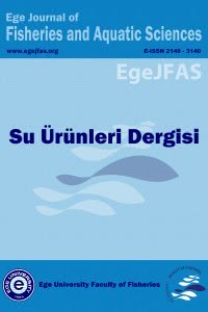Bazı uçucu yağların Scenedesmus subspicatus büyümesi üzerine etkileri
Effect of some essential oils on the growth of Scenedesmus subspicatus
___
- McCage, C.M., Ward, S.M., Paling, C.A., Fisher, D.A., Flynn, P.J. & McLaughlin, J. L. (2002). Development of a paw paw herbal shampoo for the removal of head lice. Phytomedicine, 9(8), 743-748. DOI: 10.1078/094471102321621377
- OECD (2011), Test No. 201: Freshwater Alga and Cyanobacteria, Growth Inhibition Test, OECD Publishing, Paris.DOI: 10.1787/9789264069923-en
- Parlak, H., Arslan, O.C., Boyacioglu, M. & Karaaslan, M.A. (2009). Ekotoksikoloji. Ege Üniversitesi Su Ürünleri Fakültesi Yayınları, (79), 9-14.
- Minaiyan, M., Ghannadi, A. R., Afsharipour, M. & Mahzouni, P. (2011). Effects of extract and essential oil of Rosmarinus officinalis L. on TNBS-induced colitis in rats. Research in Pharmaceutical Sciences, 6(1), 13-21.
- Pavela, R. (2015). Essential oils for the development of eco-friendly mosquito larvicides: a review. Industrial Crops and Products, 76: 174-187. DOI: 10.1016/j.indcrop.2015.06.050
- Rodrigues, K.A.D.F., Dias, C.N., do Amaral, F.M.M., Moraes, D. F., Mouchrek Filho, V. E., Andrade, E. H. A. & Maia, J. G. S. (2013). Molluscicidal and larvicidal activities and essential oil composition of Cymbopogon winterianus. Pharmaceutical biology, 51(10), 1293-1297. DOI: 10.3109/13880209.2013.789536
- Laborda, R., Manzano, I., Gamón, M., Gavidia, I., Pérez-Bermúdez, P., & Boluda, R. (2013). Effects of Rosmarinus officinalis and Salvia officinalis essential oils on Tetranychus urticae Koch (Acari: Tetranychidae). Industrial Crops and Products,48, 106-110. DOI: 10.1016/j.indcrop.2013.04.011
- Conti, B., Flamini, G., Cioni, P.L., Ceccarini, L., Macchia, M., & Benelli, G. (2014). Mosquitocidal essential oils: are they safe against non-target aquatic organisms? Parasitology research,113(1), 251-259. DOI:.1007/s00436-013-3651-5
- Hammer, K.A., Carson, C.F., Riley, T.V., & Nielsen, J B. (2006). A review of the toxicity of Melaleuca alternifolia (tea tree) oil. Food and chemical toxicology,44(5), 616-625. DOI: 10.1016/j.fct.2005.09.001
- Govindarajan, M. & Benelli, G. (2016). α-Humulene and β-elemene from Syzygium zeylanicum (Myrtaceae) essential oil: highly effective and ecofriendly larvicides against Anopheles subpictus, Aedes albopictus, and Culex tritaeniorhynchus (Diptera: Culicidae). Parasitology research,115(7), 2771-2778. DOI: 10.1007/s00436-016-5025-2
- Bernhoft, A. (2010). A brief review on bioactive compounds in plants. Bioactive compounds in plants-benefits and risks for man and animals: 11-17.
- Boyacıoğlu, M., Arslan, Ö.Ç., Parlak, H. & Karaaslan, M. A. (2007). Mutagenicity of nonylphenol and octylphenol using Salmonella Mutation assay. Ege Journal of Fisheries and Aquatic Sciences, 24(3-4), 299-302.
- Ferreira, R.C.F. & Graça, M.A.S. (2002). A comparative study of the sensitivity of selected aquatic plants to mining effluents. Limnetica, 21(1-2), 129-134.
- Geetha, R. V. & Roy, A. (2014). Essential Oil Repellents- A Short Review. International Journal of Drug Development and Research,6(2), 20 – 27.
- Gunduz, G., Parlak, H., Arslan, Ö.Ç., Boyacioglu, M. & Karaaslan, M. A. (2013). Embryotoxic effects of Perfluorooctane Sulfonate Compounds in sea urchin Paracentrotus lividus. Fresenius Environmental Bulletin, 22(1A), 171-177.
- Anonymous, (2017b). http://www.esperis.it/uploads/tx_esperisproduct/ oles14.pdf
- Anonymous (2016). Guidelines on the Environmental Assessment of Natural Complex Substances (NCS). EFEO/IFRA. Version 01. 2016.
- Anonymous (2017a). http://www.earthisland.org/journal/index.php/ elist/eListRead/the_ environmental_impcct_of_essential_oils/
- Arslan, O.C. & Parlak, H. (2007). Embryotoxic effects of nonylphenol and octylphenol in sea urchin Arbacia lixula. Ecotoxicology,16(6), 439-444.DOI: 10.1007/s10646-007-0147-z
- Arslan, Ö.Ç., Parlak, H., Boyacıoğlu, M. & Karaaslan, M. A. (2015). Acute toxicity of several esential oils on Daphnia magna (Straus, 1816). Su Ürünleri Dergisi, 31(3), 137-143. DOI: 10.12714/egejfas.2014.31.3.04
- Bakkali, F., Averbeck, S., Averbeck, D. & Idaomar, M. (2008). Biological effects of essential oils–a review. Food and chemical toxicology,46(2), 446-475. DOI: 10.1016/j.fct.2007.09.106
- ISSN: 1300-1590
- Yayın Aralığı: 4
- Başlangıç: 1984
- Yayıncı: Aynur Lök
TUĞÇE ŞENSURAT GENÇ, CELALETTİN AYDIN, MUHAMMED ATAMANALP
F. Ozan DÜZBASTILAR, ALTAN LÖK, ALİ ULAŞ
Designing of ultraviolet irradiation unit: Effects on disinfection performance and operating costs
Hande DOĞRUYOL, Zafer CEYLAN, Gülgün F. ÜNAL ŞENGÖR
Endüstriyel balıkçı gemilerinde L tipi matris yöntemi ile risk değerlendirmesi ve kullanılabilirliği
MELEK ÖZPİÇAK, SEMRA SAYGIN, Enes HANÇER, Aykut AYDIN, SAVAŞ YILMAZ, Nazmi POLAT
Su ürünleri yetiştiriciliğinde biyoyumak teknolojisi
Synurella cinsinin Türkiye’deki dağılımına genel bir bakış (Crustacea: Amphipoda)
